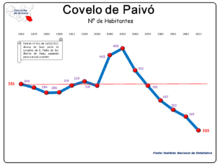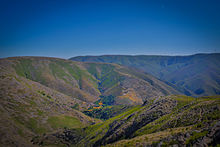Covelo de Paivó
| Covelo de Paivó | ||||||
|---|---|---|---|---|---|---|
|
||||||
| Basic data | ||||||
| Region : | Norte | |||||
| Sub-region : | Porto metropolitan area | |||||
| District : | Aveiro | |||||
| Concelho : | Arouca | |||||
| Freguesia : | União das Freguesias de Covelo de Paivó e Janarde | |||||
| Coordinates : | 40 ° 53 ′ N , 8 ° 10 ′ W | |||||
| Postal code : | 4540-281 | |||||
| politics | ||||||
| Website: | www.covelodepaivo.aroucanet.com | |||||
Covelo de Paivó (formerly Covêlo de Paivó ) is a place and a former municipality in Portugal and is located in the landscape of the Geoparque de Arouca , a geopark of the worldwide UNESCO program.
The abandoned mountain village of Drave , known as Aldeia Mágica ( Portuguese for "magic village") , belonged to the municipality of Covelo de Paivó.
history
Finds show a settlement before the time of the Romans . These also left traces here, especially the discovery of a richly worked gold bracelet weighing 171 grams in 1946.
The current location may have been rebuilt during the Reconquista and was first mentioned in a document from 1069. In the 11th century, Sesnando Davides gave the area of the later community to the Arouca monastery .
The royal registers of 1527 led Coveló de Paivó as one of three places in the municipality of São Martinho das Moitas .
1706 the place was led as the seat of its own municipality, belonging to the district Gafanhão , 1758 belonging to the district Lafões . The parish later became part of São Pedro do Sul County , to have been part of Arouca County since 1917 .
The local tungsten mines were particularly important during World War II . This was followed by a strong migration to the cities and abroad that has continued ever since.
With the territorial reform of 2013, the municipality of Covelo de Paivó was dissolved and merged with Janarde .
administration
Covelo de Paivó was the seat of a municipality of the same name ( Freguesia ) in the district ( Concelho ) of Arouca in the Aveiro district . 103 inhabitants lived in the municipality on an area of 26.48 km² (as of June 30, 2011).
The following localities are in the area of the former municipality:
- Covelo de Paivó
- Drave
- Pego
- Regoufe
With the territorial reform on September 29, 2013 , the municipalities of Covelo de Paivó and Janarde were merged to form the new municipality of União das Freguesias de Covelo de Paivó e Janarde . Covelo de Paivó became the seat of this newly formed municipality.
Sights and culture
In the Geoparque de Arouca u. a. Hiking, climbing, mountain biking and mountaineering are operated, various hiking trails are laid out. With the short hiking trails PR 13 and PR 14 there are two official routes of the Portuguese hiking umbrella organization .
The single-nave baroque parish church Igreja de São Pedro from the first half of the 18th century is a listed building .
The listed mountain village of Drave, uninhabited since 2000, attracts thousands of visitors every year.
Web links
- Website of the former municipality of Covelo de Paivó (port.)
- Entry on Covelo de Paivó in the Mapas de Portugal
Individual evidence
- ↑ History of the municipality of Covelo de Paivó ( Memento of the original from April 24, 2017 in the Internet Archive ) Info: The archive link has been inserted automatically and has not yet been checked. Please check the original and archive link according to the instructions and then remove this notice. , Website of the former Covelo de Paivó municipality, accessed on April 23, 2017
- ↑ a b c Entry of the village Drave in the Portuguese list of monuments SIPA (under Cronologia ), accessed on April 23, 2017
- ^ Publication of the administrative reorganization in the Diário da República gazette of January 28, 2013, accessed on October 1, 2014
- ↑ Entry of the Igreja Paroquial de Covelo de Paivó in the Portuguese list of monuments SIPA, accessed on April 23, 2017



